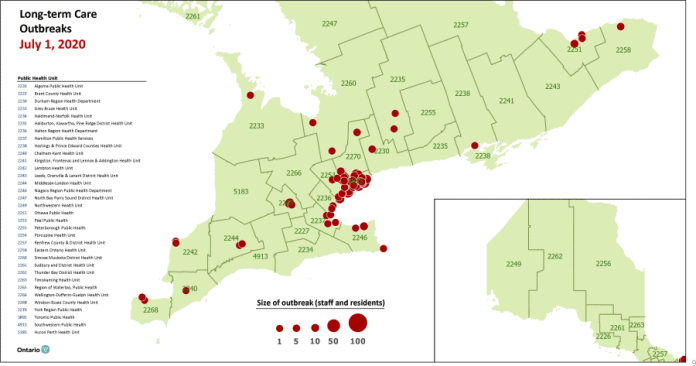
On Tuesday (January 12), Ontario’s top public health officials shared the COVID-19 modelling projections that Ontario Premier Doug Ford said last week would make people “fall off your chair”.
Adalsteinn Brown, the dean of the Dalla Lana School of Public Health at the University of Toronto, presented the modelling projections at a media conference at Queen’s Park.
“We’re at a dangerous point,” Brown said. “The number of cases in Ontario is growing between three per cent and five per cent almost every day. There are already more than 400 COVID-19 patients in our intensive care units, and mortality in our long-term care homes is now on a pace to exceed the tragedy of the first wave.”
Brown noted that COVID-19 is now in every region of Ontario.
“This is no longer a problem of a small group of cities or one region of the province,” he said. “More than half of our intensive care units are full, or only have one or two beds left.”
With COVID-19 ICU occupancy now over 400 beds, surgeries are being cancelled and the access to care continues to decline below 2019 levels.
“The pandemic will have serious consequences for our health in every region of Ontario,” Brown said. “As we climb closer to a thousand intensive care beds — about half of our capacity — filled with COVID-19 patients in February, we will have to confront choices that no doctor ever wants to make, and no family ever wants to hear.”
“There will be choices about who will get the care they need and who will not,” he added. “There will be choices about who receives oxygen or is transported to hospital — decisions we are already seeing being forced on ambulance crews in California, where the virus has spread widely.”
“I want to emphasize that the choices will affect all patients needing intensive care, whether it’s patients who have a heart attack, who’ve been in a motor vehicle accident, who have COVID-19 or any other cause.”
Brown added that surgeries will be delayed or cancelled, and that delays in care will result in poorer outcomes for patients.
The situation is also dire for residents of Ontario’s long-term care homes, with almost 40 per cent of homes now having active COVID-19 outbreaks. So far in the second wave, 1,119 long-term care residents have died from COVID-19, compared to just over 1,900 in the first wave. In the worst-case scenario, Brown said, this number will exceed 2,600 by February 14.

Despite current levels of restrictions, growth in cases across Ontario has accelerated and is over seven per cent on the worst days, Brown said. The growth in cases is attributed to a large minority of Ontarians — almost a third — not following public health restrictions.
A recent survey of Ontarians found that 35 per cent of respondents said that people in their neighbourhoods were either occasionally or never practising physically distancing. Of those surveyed, 32 per cent said three or more people outside their household had visited their house for a meal, celebration, or stay over in the past month. Of these respondents, 34 per cent of these said they didn’t observe public health restrictions.
“If we do hit the five per cent level of growth, which is quite possible, we’ll be looking at over 20,000 cases per day by the middle of February,” Brown warned. “And if we get into a darker situation with seven per growth, we’ll be looking at over 40,000 cases per day”.
Daily mortality is also increasing under current restrictions, and is projected to double from 50 to 100 deaths per day between now and end of February.
“This would really put COVID-19 into competition for being the single greatest cause of mortality on a daily basis, potentially larger than cancer and heart disease,” Brown said. “It’s already larger than virtually any other cause that we look at, but this would put it into the first position.”
Brown also said the new variant of the virus causing COVID-19 could affect modelling projections.
Novel SARS-CoV-2 variant B.1.1.7 — commonly called the UK variant as it was first identified in southeast England in November — is much more easily transmitted. While it is not more virulent and responds to vaccines, if B.1.1.7 spreads in the community, the growth of new cases could accelerate even more, with cases doubling in just 10 days in March.
Dr. Barbara Yaffe, Ontario’s associate chief medical officer of health, said there are now eight known cases of B.1.1.7 in Ontario, five of which are connected to travel to the U.K.
In response to the new modelling projections, Premier Doug Ford will be announcing further restrictions at Queen’s Park on Tuesday afternoon.
PDF: Update on COVID-19 Projections – January 12, 2021
Update on COVID-19 Projections - Science Advisory and Modelling Consensus Tables - January 12, 2021
Downloadable version


























